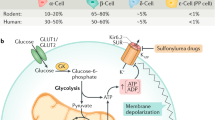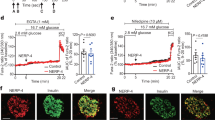Abstract
THE level of glucose in the blood perfusing the islets of Langerhans is thought to regulate the secretion of insulin by the β-cells1. At present nothing is known about the mechanism of this regulation or even about the way in which the β-cells metabolize glucose. Studies designed to provide information about these problems are hampered by the fact that the pancreatic islets are rather diffusely scattered throughout the entire exocrine portion of the gland and comprise only about 2 per cent of the total pancreatic tissue2. Even if one were successful in obtaining islet tissue free of exocrine pancreas, the β-cells represent only 60–90 per cent of the total cell population3. However, in humans there are insulin-producing tumours of the pancreas which are usually composed of only β-cells and such tissue does afford an opportunity to study β-cell metabolism. A ratio greater than unity for the amount of carbon dioxide labelled with carbon-14 derived from glucose-1-14C as compared to that from glucose-6-14C has been taken as evidence for the existence of the hexose monophosphate pathway in the tissue under study4. The present report concerns studies using a β-cell tumour and indicates that there is an active hexose monophosphate pathway in these cells (this patient was studied through the kindness of the National Institute of Neurological Diseases and Blindness, National Institutes of Health, Bethesda, Md.). It is realized that the metabolism in these benign tumours may not be completely analogous to that of β-cells in normal islets.
This is a preview of subscription content, access via your institution
Access options
Subscribe to this journal
Receive 51 print issues and online access
$199.00 per year
only $3.90 per issue
Buy this article
- Purchase on Springer Link
- Instant access to full article PDF
Prices may be subject to local taxes which are calculated during checkout
Similar content being viewed by others
References
Anderson, E., and Long, J. A., Endocrinol., 40, 92 (1947).
Hartroft, W. S., Diabetes, 5, 98 (1956).
Volk, B., Lazarus, S., and Goldner, M., Arch. Int. Med., 93, 87 (1954).
Bloom, B., and Stetten, jun., D., J. Amer. Chem. Soc., 75, 5446 (1953).
Bailey, C. C., in “Vitamins and Hormones”, 7, 365 (Academic Press, New York, 1949).
Siperstein, M. D., Diabetes, 7, 181 (1958).
Wilson, J. D., and Siperstein, M. D., J. Clin. Invest., 38, 317 (1959).
Author information
Authors and Affiliations
Rights and permissions
About this article
Cite this article
FIELD, J., JOHNSON, P., HERRING, B. et al. Evidence for the Hexose Monophosphate Pathway for Glucose Metabolism in Human Pancreatic β-Cells. Nature 185, 468–469 (1960). https://doi.org/10.1038/185468a0
Issue Date:
DOI: https://doi.org/10.1038/185468a0
This article is cited by
-
Species variation in the islets of langerhans
Diabetologia (1979)
-
Factors controlling insulin secretion in vitro
Acta Diabetologica Latina (1969)
-
Pentitols and the Mechanism of Insulin Release
Nature (1967)
-
Effects of intravenous injection of xylitol on blood sugar, blood pyruvic acid and plasma insulin levels in the dog
Zeitschrift für Die Gesamte Experimentelle Medizin einschließlich experimentelle Chirurgie (1967)
-
Histoenzymologie du pancreas endocrine de l'homme
Histochemie Histochemistry Histochimie (1966)
Comments
By submitting a comment you agree to abide by our Terms and Community Guidelines. If you find something abusive or that does not comply with our terms or guidelines please flag it as inappropriate.



